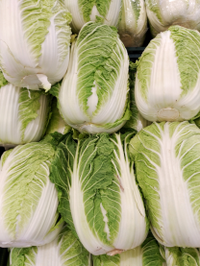
Photo from wikipedia
A surplus of unused parts of vegetables (e.g., white cabbage [cabbage] cores and outer leaves) is generated daily by factories of fresh-cut vegetables. These parts are difficult to effectively utilize… Click to show full abstract
A surplus of unused parts of vegetables (e.g., white cabbage [cabbage] cores and outer leaves) is generated daily by factories of fresh-cut vegetables. These parts are difficult to effectively utilize and are often discarded as biodegradable industrial waste. This study aimed to develop an efficient method for producing l-ornithine from cabbage residues. First, we added protease (Sumizyme FP) to the cores and outer leaves of sterile cabbages. After 8 days, the amount of l-arginine released was approximately fivefold the amount in the initial content. As l-arginine is a precursor of l-ornithine, the addition of protease combined with Pediococcus pentosaceus produced l-ornithine. However, the rapid lactic acid fermentation suppressed the metabolism of l-arginine to l-ornithine, which we overcame by adjusting the pH by adding eggshell. The anaerobic fermentation of the cores and outer leaves of sterile cabbages with 5% eggshell for 8 days produced 184 ± 2 μmol of l-ornithine/100 g cabbage. PRACTICAL APPLICATIONS: This level of l-ornithine production is higher than that observed in freshwater clams (81-116 μmol/100 g), which are considered to be high in l-ornithine. This method can be applied to the production of inexpensive and safe l-ornithine-containing food materials derived from vegetables. Furthermore, ingestions of vegetables fermented by this method would provide a variety of health benefits of l-ornithine. The widespread adoption of this method will not only reduce the amount of waste generated daily from fresh-cut vegetable factories, but will also enable upcycling as a higher value-added food material.
Journal Title: Journal of food biochemistry
Year Published: 2022
Link to full text (if available)
Share on Social Media: Sign Up to like & get
recommendations!